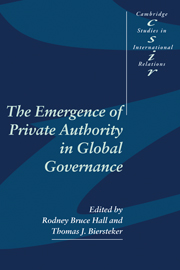Book contents
- Frontmatter
- Contents
- List of figures
- List of tables
- List of contributors
- Preface and acknowledgements
- Part I Introduction: theorizing private authority
- Part II Market authority: globalization and “globaloney”
- Part III Moral authority: global civil society and transnational religious movements
- 6 “Regulation for the rest of us?” Global civil society and the privatization of transnational regulation
- 7 The global dimensions of religious terrorism
- Part IV Illicit authority: mafias and mercenaries
- Part V Conclusions and directions
- Bibliography
- Index
- CAMBRIDGE STUDIES IN INTERNATIONAL RELATIONS
7 - The global dimensions of religious terrorism
Published online by Cambridge University Press: 22 September 2009
- Frontmatter
- Contents
- List of figures
- List of tables
- List of contributors
- Preface and acknowledgements
- Part I Introduction: theorizing private authority
- Part II Market authority: globalization and “globaloney”
- Part III Moral authority: global civil society and transnational religious movements
- 6 “Regulation for the rest of us?” Global civil society and the privatization of transnational regulation
- 7 The global dimensions of religious terrorism
- Part IV Illicit authority: mafias and mercenaries
- Part V Conclusions and directions
- Bibliography
- Index
- CAMBRIDGE STUDIES IN INTERNATIONAL RELATIONS
Summary
During the Cold War, America's prime enemy was the vast Soviet empire. Ten years after the fall of that empire, America's most wanted enemy was a single person – Osama bin Laden – a man without a state. Shunned by his native Saudi Arabia, bin Laden encamped in various places, most often in Afghanistan, where even the Taliban have found him to be a difficult guest. But he did not represent them or any other state, not even a rogue regime.
Bin Laden is not, however, a complete anomaly. He symbolizes a variety of movements of religious activism that despise the symbols of secular power in a global age, and he is a significant authority figure within a transnational network that encompasses a certain segment of these disgruntled activists. In America's anguish after the savage aerial assaults on the World Trade Center and the Pentagon on 11 September 2001, a critical question was how to retaliate: who or what should be attacked? Clearly bin Laden was implicated, as he was in the previous assault on the World Trade Center in 1993 and the bombing of American embassies in Africa in 1998, but an appropriate response to these attacks was the subject of a great deal of debate both within and outside American diplomatic circles. In attempting to defeat bin Laden, no one in the US administration was under the illusion that they could defeat terrorism everywhere, nor banish all of bin Laden's own brand of Islamic extremism.
- Type
- Chapter
- Information
- The Emergence of Private Authority in Global Governance , pp. 141 - 158Publisher: Cambridge University PressPrint publication year: 2002

